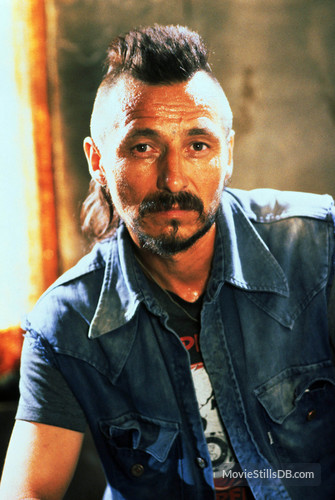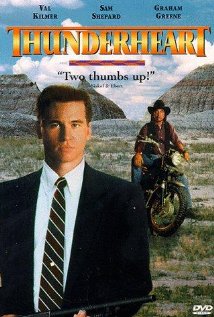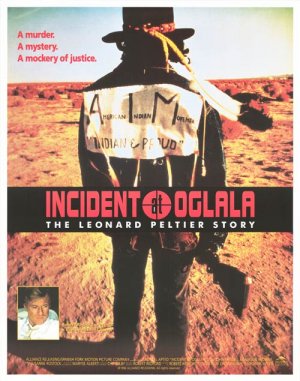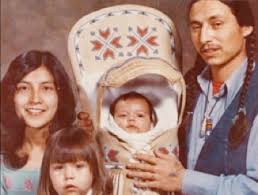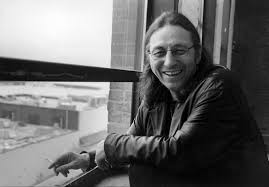“…an Indian is someone you rob, someone you steal from.”
If you’re into “Serial,” “The Jinx” or “Making of A Murderer,” check out “Incident at Oglala,” a 1992 documentary about Leonard Peltier, a Native American activist imprisoned for two murders there is reason to believe he did not commit. You will also meet John Trudell, Pelletier’s fellow-activist, who had an unsolved true crime story of his own: Trudell’s pregnant wife, three children and mother-in-law died in a fire that may have been set at the instigation of the FBI (the same FBI, I must note as a Bostonian, then engaged in abetting gangster-murderer-informer Whitey Bulger).
Fire investigators said the blaze was “of suspicious origins,” but their investigation went no further. Trudell believed his family was murdered. He did not think it mere coincidence that on February 11, 1979, the day before the fatal fire, he had burned an American flag at a demonstration in front of FBI headquarters in Washington D.C.
Original Interview Audio:
A leader of the American Indian Movement (AIM) at that time, Trudell said the flag-burning was a protest against unjust and racist policies that he felt desecrated what the flag was intended to represent. The next day Trudell’s home on the Shoshone-Paiute reservation in Nevada burned to the ground.
I spoke to Trudell 13 years after this event, when he was finding recognition as a poet, actor and recording artist. Forty-six years old at the time, Trudell had just released his first nationally distributed album, “AKA Grafitti Man,” one of the most listenable and powerful spoken word albums ever made thanks to Trudell’s searing verse and the music of the late Kiowa Indian guitarist Jesse Ed Davis, known for his work with Taj Mahal, John Lennon, George Harrison, Eric Clapton and Jackson Browne (that’s Jesse on “Doctor My Eyes,” to pick out one notable solo).
Around the same time as his CD’s release, Trudell was appearing in two movies, both directed by Michael Apted. One, “Thunderheart,” starred Val Kilmer in a fictionalized account of the 1973 Wounded Knee protest. The other was “Incident at Oglala,” produced and narrated by Robert Redford, which examined the FBI’s pursuit of Peltier, who remains in prison today after being convicted in 1977 of the murder of two FBI agents in a shootout at the Pine Ridge Indian Reservation in 1975 (You can watch “Incident at Oglala” here: www.freepeltiernow.org/incident].
As eager as I was to talk to Trudell about “AKA Grafitti Man,” one of that year’s most notable recordings, I did not relish having to ask him about the death of family. I needn’t have worried. Trudell did not flinch. He was a warrior who would not let even the deaths of those closest to him to deter him from his mission; and he was a poet-shaman who found strength putting his and his people’s pain into words.
John Trudell died from cancer at age 69 on December 8, 2015.
April, 1992
From Los Angeles by phone
When did you first start adding music to your words?
1982 was the first pass at it – to just lay the poetry on the oldest musical form. I went into my own culture to do that. By 1983 I wanted to combine the poetry with the newest musical forms – drums, synthesizers and electric guitars. But I didn’t get an opportunity to do that until 1985 when I met Jesse Ed Davis. I met Jesse and he said he could make music from my words. So we went for it. That was the origin of the [first] album “AKA Grafitti Man.” We recorded that in the summer of ‘85. We shopped it around record companies. They all listened, but no one picked it up. So we made a label ourselves, the Peace Company, and put it out. We continued on with the process of making new songs. The first album, that’s why it became “AKA,” because there’s a song on it called “Lavender’s Blues.” I wanted that to be the name of the album, but Jesse preferred “Grafitti Man, because musically it was happening more the way he wanted it to be. So on the master tapes I wrote “Lavender Blues” and Jesse added “AKA Grafitti Man.” So in the end that became the name that stuck.
Why “Grafitti Man”?
It had to do with political messages on walls. It was just everywhere in the course of my travels. But what I’m looking at, what I was attempting to do, was grafitti. The walls of the mind. In this day and age everyone is putting up walls. So to me, it was putting grafitti on those walls.
Was Jessie’s death [in 1988, at age 43, probably from a heroin overdose] a setback?
It was a setback in the sense that I didn’t have Jesse anymore, my friend. But in the professional sense, in the clinical sense, it wasn’t a setback. Mark Shark, my guitar player now, was the guitar player in our band and had worked with Jesse for three or four years by that time. It was like family, everyone in the band. Jesse was the leader, but he taught Mark a lot. And he’s an incredible musician. So it was a continuation, a progression, from the albums I did with Jesse to what I’m doing with Mark now.
So this new album is a compilation?
Everything was remixed. The original “Grafitti Man” album was done in an 8-track studio, so there were technical adjustments that needed to be made. If Jesse had lived, that was always his intention. Those 8-tracks were our demos, right? We did everything we could to protect the integrity of his playing. Because this is, basically, the last of his music. I know he did some songs with Dylan that haven’t been released yet, but I have the last of his original work.
So before this release on Ryko you had five previous albums?
I’ve had to stop distributing it because of an agreement with Ryko. We’ll see how things go. At some point I would like to rerelease the material in its original form. We have more material where we really utilize Quiltman, the tribal singer. The next album, we’ll use more of him. It was just the luck of the draw on the selection of this one. Two of the earlier albums were with Quiltman – “Tribal Voice” – and it was the poetry with the traditional drums and singers. And two of the albums were Grafitti [Band] albums. And there’s a fifth album that I co-wrote with Mark Shark, with a song or two by Quilt and Jesse. So when it came time to do this compilation we drew mainly on the Grafitti [Band] material. The next thing that comes out will have more of the tribal sounds integrated with the band. The poetry is the core of it. Every line is spoken. But there are things that are sung and we’re experimenting with more and more of that.
Do your songs all start out as poems?
Some of them. Some of them I write knowing that there will be music, so I try to make it more comfortable for the music. If I can find a rhythm in a line then I trust that my partner can find it musically.
Did you start out by doing poetry readings?
Working in front of groups of people – I’ve always been able to do that. I started out as a political activist. I did a lot of public speaking, which wasn’t off of paper. When I started writing I had to get used to working off of paper. Once I had been writing poems for a year my compulsion was to go out and impose them on whatever audience happened to be in front of me. The deal is it became well received. The next thing became working with musicians. Once I started working with musicians, that was the test to me, because I was used to working by myself, because I’m not a musician. I don’t know a note from a letter. I don’t know a harmony from a melody or what all that means. I’m not a dancer, I’m not a singer. If I was going to get on that stage I was going to have to talk my way in there, that was all there was to it. I did it with the “Tribal Voice” music in ‘82. Just drum and indigenous song. With the electric music, it started in ‘86 that I did my first performance. We played as many shows as we could get so I could learn to work with a band. After a year and a half, we didn’t play as much. But we stay busy in the course of a year.
And what’s with the band now? Are you looking to expand it?
I like the sounds we make with what we have. I have this thing about rock and roll and the things I hear in my own head. Everyone in this band was brought to me by Jesse Ed Davis. I have no inclination to change my band. We’ve all been a part of this for a long time.
How many members of the band are Native Americans?
Just Quiltman doing traditional singing and percussion.
Tell me about your relationship with Jackson Browne.
Without Jesse Ed and Jackson Browne there would be no music. Jackson’s been part of this from the get-go, for the last 13 years. He’s been an ally to me. None of this would have happened without his participation. I didn’t want him to use his show business place to further me. I have to do this. It’s not something that someone else can do for me. But he’s been very supportive in a multitude of ways over the years. And he was very instrumental in getting the deal with Rykodisc. Politics is a part of our relationship, but it’s deeper than that. There was a time in my life when I needed an ally and it happened to be him.
Was there a plan to have your album come out at the same time as these movies you’re in?
It’s a combination of things. Coincidence, luck, chance, whatever you want to call it, plays a role in this. But there’s also the course I’ve chose to follow. But it’s a combination of elements. I got through making my record and these two films, and Michael Apted, we entered one another’s worlds here, but in a way it was by chance. I did the interview for “Incident [at Oglala].” Then “Thunderheart” came and I agreed to be Jimmy Looks Twice. But no matter how good my plan may be, if I couldn’t pull it off, if I couldn’t be credible with an audience….The timing is very fortunate for me. I remember thinking six years ago, “Wouldn’t it be nice if I could get exposure from more than one medium simultaneously?” I remember that. “Wouldn’t it be nice?” But it was very abstract. It’s a bit of a whirl to me to see it happening now.
So Michael Apted offered to give you a screen test after he interviewed you for “Incident at Oglala”?
I was in a movie before, “Pow Wow Highway” [in 1989]. I had two scenes. But my character had no character. I was a prop with some lines. But it was very agreeable to do because I have an interest in acting. I wanted to find out if I could work in front of a camera, because if the camera doesn’t like you, then you give it up. But I felt I could work with the camera. I had the interest. But I’m not an actor in the sense that I’m going out looking for any role. I’m an actor who’s not looking for parts. But talk about chance! Here comes a part for me [Jimmy Looks Twice, in “Thunderheart”] that comes along that was compatible with my attitude. I read the script, I could identify with the character, so yeah. One of the things that was ideal about this character was that this character has a lot of visibility in the film even though he’s only in a couple of scenes. I was getting an opportunity to play a high profile character without having to back it up with too much acting. I didn’t have to carry the film.
Did you get your hair cut short for movie?
That was just the way I looked at the time. I mentioned attitudes. In 1990 they had this thing going on in Canada, a confrontation between the Indigenous Peoples, the Mohawks, and the Canadian government.So that was my act of solidarity with what the Mohawks were attempting to do up there. I couldn’t go there and participate so I thought, well, I’ll just wear my hair Mohawk style for one year. And during this time we did the interview for “Incident.” And for “Thunderheart,” they had to change my character quite a bit. The Mohawk thing worked. I didn’t want to wear the hot wig they originally wanted me to.
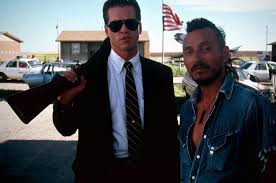
Were you there when the actual incident at Oglala took place? [In June, 1975, two FBI agents were slain following a gun battle in the Jumping Bull Compound in Oglala, South Dakota. Also killed was a Native American, Joe Stuntz, a member of the American Indian Movement, whose death prompted no legal action. The FBI agents claimed to be looking for a suspect in the theft of a pair of cowboy boots. The government arrested four AIM members who were on the compound at the time. One was let off because of insufficient evidence; two were acquitted by a jury. The fourth, Leonard Peltier, was extradited from Canada on the strength of sworn affidavits that prosecutors later admitted to be coerced fabrications.]
I happened to be in Norman, Oklahoma, when that firefight started. I drove up to South Dakota the next morning. I was in and out of that area before and after the firefight. I was very skeptical by that time of the government’s side of the story. And I was very concerned about the people living in that camp. I knew people who lived there. It was a matter of concern about my own partners.
And was that before you became head of the American Indian Movement?
I became chairman of AIM in the fall of 1973.
In “Thunderheart,” the FBI is treated as a kind of neutral force. Is that accurate?
There was a reality to the ignorance of the FBI. When I was sitting there with the script in my hand I realized it was only a movie. In reality, there were no FBI agents that became nice guys, that had a conscience or a burst of consciousness. In reality, it wasn’t even close to that. I remember thinking when I was reading the script, if these people don’t have their act together this could be a bad film. But I trusted the integrity of the individuals I dealt with and went with that trust.
There’s a 17,000 page file the FBI has on you. Which seems astounding. Did you ever file a FOIA and read it?
I never went to look at it. The only way I can get access to it is to go to the J. Edgar Hoover FBI building. Or I can pay 10 cents a page for it. I choose not to do either at this point in my life. What I’m more curious about is two things. It speaks to the paranoia of those who claim to be in power. Because I know how I lived my life. I didn’t do anything in the course of my life that would justify 17,000 pages. I know what I did. At the most extreme of bizarre, there’s nothing that warrants that kind of coverage. I assume it deals with the years from 1968 to 1980. I wonder what’s been added.
Why would the government would take such measures and put so much effort into stopping the American Indian Movement?
Because we represent another perspective of life. We represent a perspective of life that says our spirit is vital to how and who we are, that our spirit is vital to our well-being. And our spirit is part of a larger spirit of life, that of the earth and the universe itself. Because we have that spiritual relationship to life we have the right to be who we are. In a society where they want the workers to behave and pay the rent, where they want the workers to go to the office, and they want the workers to put up with mistreatment and abuse, emotional and mental. They want the citizens of this society to behave themselves. So if the Indigenous Peoples, the so-called Indians, if we respect their rights as human beings, then the citizens are gonna want it.
Do the moral and legal claims of the Indigenous Peoples pose a threat to the U.S. government?
Yes. Because the whole principle of democracy, no matter what the rhetoric is, is to control everyone and turn their energy into a profit. That’s what it’s really all about. So if the Indigenous People demand the right to live as who they are then it jeopardizes everything, all of it. Because they don’t want the citizens to see what the Indians see. Because it would change everything. Yes, it would.
See, when the boats with the Europeans started coming, the two sets of Europeans that came were the owners and the owned. The owned, they liked the Indians. Because if they ran away, the Indians would take them in. That’s why racial hatred became part of the indoctrination, to keep that from happening. My feeling is the system continues to exist today. An example of that today is the Wounded Knee occupation of 1973. More people in America supported that armed occupation than supported the government in power at the time, the Nixon administration. The significance of that is tremendous, because more people sympathized with the so-called militants. The second thing that happened in this generation as a result of the American Indian Movement was that in Cedar Rapids, Iowa, in 1976 [Dino] Butler and [Bob] Robideau were acquitted of killing two FBI agents [in Oglala] on the basis of self-defense. What happened was you had a nice average white jury saying, yes, we recognize that you may have to defend yourself against the government even when the government says it’s acting in the line of duty. The implications of that are truly revolutionary. The government in this situation has to keep everything under control. When you have a political meeting there’s always someone who comes to the meeting to run back and tell on you. Look at this clearly. We’re dealing with a democratic government that has all the power, controls the economy, the politics, the means of destruction, the religion, and it controls the enforcement of the law. Yet they are paranoid about a group of people getting together and exchanging ideas. There’s a reality there that should not be ignored.
Your family was killed in a fire. It was suspicious, it was investigated, but no one was ever accused of anything in connection with it. Who do you believe was responsible?
I don’t believe anything, because to believe is an assumption. It means there’s doubt. I do know that people connected to the American government started this fire and that other individuals connected to the government did the cover up. There was the assassination and there was the cover up of the assassination, the misinformation that it was an accident, et cetera. That I did know. There are individuals whose names and roles in this I know. I have not forgotten them at all. I would not say their names because if something happens to them I don’t want people beating on my door about it.
These individuals….who did they work for?
There is an FBI connection. That’s part of it. What I was told is that the FBI had a different operation. They were trying to set me up for a sting. The fire was initiated by someone who was considered a loose cannon and belonged to another organization. The FBI had to call off the sting of me after the fire.
It seems as if those days of direct confrontation with the government are over. Where is the American Indian Movement at now?
I’ll answer it like this. The consciousness of the people is alive. The spirit of the people lives. In that sense the movement is still happening. AIM, part of that is still functioning in different areas. But it is not a national organization. I think that in my lifetime we will never attempt to create a political structure the way we did with AIM. It was centralized for the government, who they need to destroy. The reality was, if we show our faces, they get us.
Does your present activities as a public figure in the media offer you security by increasing your visibility?
I think it places me in more danger. I think at this time I am probably the target of a counterintelligence program. I have reason to suspect that. I’ll have to see what unfolds in the next year. I survived my destruction with at least a shred of coherency.
Have conditions on the reservation changed? Are they still as bad as they were before?
I think in ways they are. People are poor. The poverty is overwhelming, especially on the reservation. The water is becoming contaminated. Accessibility to hunting and fishing is becoming more restrictive. Health services…if there’s no money for health services for the general public, imagine what that does for us. In some ways conditions are much more harsh. But when I talk about the spirit of our people and our culture, I see that it’s flourishing despite these things. The spirit has not been broken. In context of what happened 16 years ago, any people who see this and dismiss it, they dismiss the principles of democracy in action and maybe their own future.
Don’t you mean the perversion of democracy?
I don’t know. I have to look at it this way: My people were free. Democracy imprisoned us. My people were not on the verge of extinction. Democracy keeps us on the verge of extinction. I have to look at it realistically. Look at society in general. Women are still second-class citizens looking for equality. Who did that to them? Look at your white male who doesn’t own property. He has to worry about how he’s going to feed his family. Look at blacks. Look at the foot-on-your-throat situation so many citizens of this country are in. And what I find bizarre, they are afraid to even question whether democracy is the right way for them to live or not. I’m not talking about communism or any of these other parasite, predator, vampire systems. I’m talking about the democratic society we live in, where many people will dislike me just because I question democracy. And I think I have valid reasons to question it.
See, I come from the tribe. The tribe is the way things should be. But I’m not going to impose that on anyone, that’s just my view. But larger than that, we have a responsibility. We have the ability therefore we have the responsibility to create how we’re going to live with our environment. Nowhere is it written in the religious rules of God that we have to follow the rules of those who have been ruling us for the last 1000 years or 50 years or 20 years. What people need to look at in speaking of democracy, look at it with a clear mind. I remember when I was a child going to school and they told me about the Soviets and the KGB – political police, thought police – and you got dragged off in the middle of the night, you got persecuted for the way you looked and believed. And one day I see a KGB agent flashing an FBI badge, an IRS badge, a secret service badge, a banker’s mortgage. If anyone can tell me where the theoretical ideals of democracy have been practiced I’d be inclined to trust those ideals. But nowhere has those ideals been practiced. Maybe it can be made real, created. But it does not exist.
You’re going to be playing the Earth Day concert here in New England next week [at Foxboro Stadium]. What do you think of Earth Day? Is it an effective forum for action and change or merely a salve to the conscious of the white middle-class?
At this point I look at individuals first and the community and the society second. We need to make peace with Earth. We need to make a conscientious peace with our relationship to the Earth. If we will make that step the rest of it will fall into place. But we need to reconnect ourselves with what it’s all about. People who recycle newspapers, bring back deposit bottles, they are trying to know more about what is happening. We don’t need peace on Earth, we need peace with Earth. Our power comes from Earth. Earth gives us life, sustains life. We really need to have an understanding of that. The majority of environmentalists want to save the Earth because they’re afraid of what will happen if we don’t. But there’s more spirit, and it’s more more real, when we say we start to do it to perpetuate life and when we appreciate life. We can achieve that state of mind.
Do you think a movie like “Thunderheart” can have an effect on the public’s attitude toward the situation of Indians?
You can have your plan, your direction you’re headed in, and there will come these opportunities along the way. It can help you or you can miss it completely or it can backfire on you. For Leonard [Peltier], I think there are some real opportunities coming up for his story to be heard. He’ll never get justice, because they’ve taken these years from his life, but maybe he can get out of prison.
I don’t have hope that it will change our situation in a positive way. Throughout our history there have been citizens who have sympathized with us. But because they could not have a say in how their own lives our governed, they could not have a say in ours. We had a common problem. Someone was misusing them too. Anyway, I don’t have a lot of hope that this will come out and save the People. What I do see happening out of it is, number one, a story is being told. People will have an opportunity to see this story. In “Incident, “Thunderheart,” whatever, they will be influenced and remember it. It will not save us, but it won’t hurt us and it may help us in the long term. At some point as they start to see that they’re the Indians now, I trust that. Because they are. When you get down to reality, the indigenous people of this land are not Indians. Never have been, never will be. They’re the People. Indians live in India. Indians is a term someone coined. They were lost and they gave us their misrepresented name because they thought they were somewhere else on the planet. So when I look at it in that context, they created this name, Indians, and to them an Indian is someone you rob, someone you steal from. They’re there for your convenience and you just take from them. Now when I look around at people who are getting their unions broken, people at Caterpillar, people who can’t get their jobs back, when I look at the poor, at the elderly who don’t know how they’ll live when they retire, at the farmers, who are the Indians now? For us as indigenous peoples, our history goes back as far as our memories. Our history as Indians go back 500 years and since then it’s been nothing but terror and genocide. What keeps us alive is that we can still remember that we’re the People.
People with a capital P?
That’s right. Capitalize all the letters!
I hear what you’re saying about the term Indian, but you don’t seem to have a problem with using it.
I prefer the word Indian over Native American. Indian is a term everyone is familiar with. I’d say Indian People. Or Indigenous People. That’s more accurate. But Indian is more identifiable. But add People to it. As far as Native American goes, anyone born in the nation state of America is a Native American. We first started our political dissent in the late ‘60s saying we want change. The government never really changes anything. They just changed what they called us. They kept on treating us the same way but called us Native Americans. It’s a very sick piece of deception. And all well-intentioned people took right up to it because they wanted to do good.
